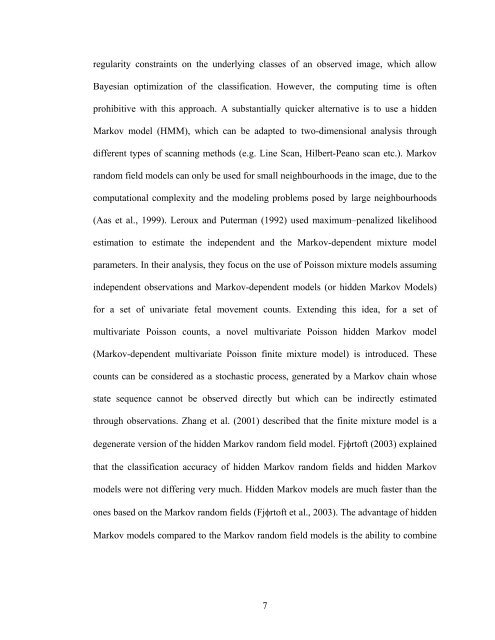multivariate poisson hidden markov models for analysis of spatial ...
multivariate poisson hidden markov models for analysis of spatial ...
multivariate poisson hidden markov models for analysis of spatial ...
Create successful ePaper yourself
Turn your PDF publications into a flip-book with our unique Google optimized e-Paper software.
egularity constraints on the underlying classes <strong>of</strong> an observed image, which allow<br />
Bayesian optimization <strong>of</strong> the classification. However, the computing time is <strong>of</strong>ten<br />
prohibitive with this approach. A substantially quicker alternative is to use a <strong>hidden</strong><br />
Markov model (HMM), which can be adapted to two-dimensional <strong>analysis</strong> through<br />
different types <strong>of</strong> scanning methods (e.g. Line Scan, Hilbert-Peano scan etc.). Markov<br />
random field <strong>models</strong> can only be used <strong>for</strong> small neighbourhoods in the image, due to the<br />
computational complexity and the modeling problems posed by large neighbourhoods<br />
(Aas et al., 1999). Leroux and Puterman (1992) used maximum–penalized likelihood<br />
estimation to estimate the independent and the Markov-dependent mixture model<br />
parameters. In their <strong>analysis</strong>, they focus on the use <strong>of</strong> Poisson mixture <strong>models</strong> assuming<br />
independent observations and Markov-dependent <strong>models</strong> (or <strong>hidden</strong> Markov Models)<br />
<strong>for</strong> a set <strong>of</strong> univariate fetal movement counts. Extending this idea, <strong>for</strong> a set <strong>of</strong><br />
<strong>multivariate</strong> Poisson counts, a novel <strong>multivariate</strong> Poisson <strong>hidden</strong> Markov model<br />
(Markov-dependent <strong>multivariate</strong> Poisson finite mixture model) is introduced. These<br />
counts can be considered as a stochastic process, generated by a Markov chain whose<br />
state sequence cannot be observed directly but which can be indirectly estimated<br />
through observations. Zhang et al. (2001) described that the finite mixture model is a<br />
degenerate version <strong>of</strong> the <strong>hidden</strong> Markov random field model. Fjφrt<strong>of</strong>t (2003) explained<br />
that the classification accuracy <strong>of</strong> <strong>hidden</strong> Markov random fields and <strong>hidden</strong> Markov<br />
<strong>models</strong> were not differing very much. Hidden Markov <strong>models</strong> are much faster than the<br />
ones based on the Markov random fields (Fjφrt<strong>of</strong>t et al., 2003). The advantage <strong>of</strong> <strong>hidden</strong><br />
Markov <strong>models</strong> compared to the Markov random field <strong>models</strong> is the ability to combine<br />
7















